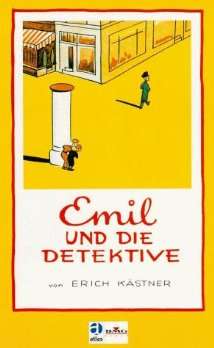Emil and the Detectives (1931 film)
| Emil and the Detectives | |
|---|---|
 Film poster | |
| Directed by | Gerhard Lamprecht |
| Produced by | Günther Stapenhorst |
| Written by |
Billy Wilder, Erich Kästner, Emeric Pressburger |
| Starring |
Rolf Wenkhaus, Fritz Rasp |
| Music by | Allan Gray |
| Cinematography | Werner Brandes |
| Distributed by | UFA |
Release dates |
|
Running time | 75 minutes |
| Country | Weimar Republic |
| Language | German |
Emil and the Detectives (German: Emil und die Detektive) is a 1931 German adventure film directed by Gerhard Lamprecht and starring Rolf Wenkhaus. It is based on the 1929 novel by Erich Kästner, who also contributed to the film's script.[1] The film script was written by Billy Wilder. Until today, this film is generally considered to be the best film adaption of Emil and the Detectives.[2]
Plot
Germany during the Weimar Republic: The film begins in the small town of Neustadt, a provincial German town which is the home to young schoolboy Emil Tischbein. His father is dead and his mother raises him alone working as a hairdresser. She sends Emil to Berlin with 140 marks (a hairdresser's monthly salary then) to give to his grandmother who lives in Berlin with his cousin, the girl Pony Hütchen. He also gets 20 marks for himself. On the way he is very careful not to lose the money and uses a needle to pin it to the lining of his jacket. On the train to Berlin, Emil meets a mysterious passenger who introduces himself as Herr Grundeis. This man gives Emil drugged chocolate and Emil falls asleep. When he wakes up, the money and Herr Grundeis are gone. He spots Herr Grundeis and follows him. Emil dares not call the police, because he made a joke with a local monument, so he feels that he is "a kind of criminal" himself. However, he meets a Berlin boy named Gustav. Gustav tries to help him and assembles local children who call themselves "the detectives".
After following Grundeis to a hotel and spying on him all night, Emil and the gang follow the thief to the bank. Emil gets his money back when Herr Grundeis tries to exchange the money. Emil proves that the money was his by describing the holes left by the needle he used to pin the bills in the lining of his jacket. Herr Grundeis tries to run away, but Emil's new friends cling onto him until a police officer arrives. Once arrested, Herr Grundeis is found out to be a notorious bank robber. Emil receives a reward of 1000 marks for capturing Herr Grundeis. In the last scene, a plane takes Emil back to Neustaat where he is greeted as a local hero.
Cast
- Rolf Wenkhaus as Emil Tischbein
- Fritz Rasp as Grundeis the thief
- Käthe Haack as Frau Tischbein
- Olga Engl as Grossmama Tischbein
- Rudolf Biebrach as Wachtmeister Jeschke
- Inge Landgut as Pony Hutchen
- Hans Joachim Schaufuß as Gustav mit der Hupe
- Hans Richter as Fliegender Hirsch
- Hans Albrecht Löhr as Kleiner Dienstag
- Hubert Schmitz as the Professor
- Ernst-Eberhard Reling as Gerold
- Waldemar Kupczyk as Mittenzwei
- Martin Rickelt as Max, real lobby boy
- Gerhard Dammann as the fat old train passenger
- Rudolf Lettinger as the Chief of Police
- Margarete Sachse as Frau Tischbein's customer
- Georg H. Schnell as the Bank teller
Reception
The film was a critical and commercial success and got also popular with international audiences. It also launched the career of Billy Wilder as a screenwriter. Mordaunt Hall wrote in his New York Times review in 1931: "It is a pity that the audience that welcomed Emil und die Detektive, a German-language children's film, to the Ufa-Cosmopolitan yesterday afternoon did not have the chance to meet the youthful actors in the flesh, as happened when this delightful picture had its premièere at the Kurfürstendamm Theatre in Berlin several weeks ago. For every one would have enjoyed seeing these clever boys, who furnish eloquent proof that Hollywood has no monopoly on juvenile screen talent. And Inge Landgut, the solitary girl in a leading rôle, is up to the high standard set by her colleagues, although a little mature for her part. Those who may imagine that American boys have exclusive rights on Indians," "Cops and Robbers," et al., will discover that such isn't the case and will settle down to enjoy the interesting and rapid development of a tale beginning with Emil (Rolf Wenkhaus) and two companions throwing dice to see who shall "remodel" a statue in Neustadt in defiance of the police and winding up with his return from Berlin in an airplane, hailed as the hero who has effected the arrest of a notorious bank robber. There are many good scenes and the photography and sound recording are excellent."[3]
British film critic Philip French from the Guardian wrote in 2013: "It's a lively, funny, exciting tale of a country mouse collaborating with streetwise city kids, and it creates a splendid picture of bustling life in the capital of Weimar Germany. One can now see its influence on two major British movies: The Lady Vanishes (1938) copies the hallucinatory sequence on a train that follows the villain giving Emil a drugged sweet, and Hue and Cry (1947) borrows the notion of smart, organised schoolkids chasing a criminal in the big city."[4]
References
- ↑ Hall, Mordaunt. "New York Times: Emil and the Detectives". NY Times. Retrieved 19 July 2008.
- ↑ Bundeszentrale für politische Bildung. "Emil und die Detektive". Retrieved 4 March 2016.
- ↑ http://www.nytimes.com/movie/review?res=9A05E5DD1F39EE3ABC4951DFB467838A629EDE
- ↑ Philip French. "Emil and the Detectives". the Guardian. Retrieved 4 March 2016.